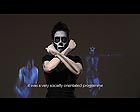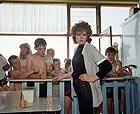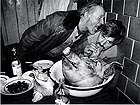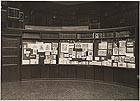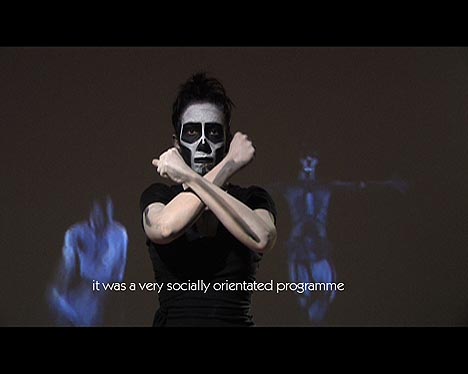
translated and summarized by: Liz Wollner-Grandville,
English summaries May 1 - 30
Grazer Kunstverein
Isa Rosenberger - Espiral
06.04.11 to 11.06.11
Turn, Spinning top, Turn
Marla Glen said recently that she prefers small rooms for concerts. Likewise, Isa Rosenberger is to be found primarily in galleries, art societies, and institutes as currently in the Grazer Kunstverein where she is showing a comprehensive project.
Rosenberger focuses on capitalist critique as, for example, Austrian banks which have expanded extensively in Eastern and Southeastern Europe and which are making, and have made, huge profits. The artist interlaces the contents expertly with the spatial planning as well as the structured dance choreography from Kurt Jooss' 1932 theater piece "The Green Table" which is danced by ballerina Amanda Piña in front of the Austrian National Bank. Symptomatically, it's death which is danced here. The central projection is a real image that looks like a requisite of a shortened, green table that establishes the visual connection to the model. Jooss composed his piece to echo the world economic crisis of 1929 in which he had men in top hat and tails - definitely powerful men - convoke on a green table which was based on a gaming table in a casino and death danced the death dance which the powerless, the workers, the uninformed investors and savers pay to the informed at the cost of the powerful. Rosenberger places photography at the forefront of the exhibition, which thus establishes the historic connection.
The main projections are two further side projections which spatially incorporate the symbol of a spiral, which is substantially represented by the financial spiral which the Austrian banks have set in motion in the new EU countries where they deduct money as profit - which they then have to transfer to other countries to domiciled mother firms.
Somewhat apart, and therefore also not in the same order, stands a work on paper about a fountain in Bratislava with a circular dance space in the middle and spiral-form oscillating wings from which waters fall like a curtain. The correlation to the rest of the project is not immediately apparent but here again, the artist interlaces content with spatial planning which makes the entire exhibition so complex, impressive and magnificent.
By Nora Theiss
Grazer Kunstverein
8020 Graz, Palais Trauttmansdorff, Burggasse 4
Tel: + 43 316 83 41 41
Fax: + 43 316 83 41 42
E-mail: office@grazerkunstverein.org
www.grazerkunstverein.org
Opening hours: Mon - Fri 10.30 a.m. – 6 p.m., Sat 10.30 a.m. – 4.30 p.m.
Christine König Galerie
Curated by - Dessislava Dimova: Anetta Mona Chi?a, Lucia Tká?ová - Material Culture
13.05.11 to 18.06.11
Ambivalence or Clarity, Street or Gallery, Art or Politics ...
In "Women, Art, and Power" (1988), the art historian Linda Nochlin showed how closely the development of feministic art history was linked with the "exciting days of the Women's Liberation Movement" in the early 1970's. A 20-part work of the two artists, Anetta Mona Chisa and Lucia Tkacova is correlated to this excitement and linkage. The Christine König Gallery shows the 20 small-format collages with black-and-white pictures taken from the history of the international women's movement in glass frames, which lean against the wall. The pictures show protests and demonstrations, women with slogans, banners and signboards: but the watchwords have been swapped around. The artists have retroactively ascribed the total ambivalence of the crusading women with red lettering on a pale background. Now they are carrying claims such as "Everything or Nothing", "Competition or Collaboration", "Mom or Dad" – sometimes several on one picture, sometimes only a single logo such as "Image or Text". On the one hand, this is amusing, but on the other also more than just the "suspense between high ideals and real life", as the curator, Dessislava Dimova, writes in the accompanying text. It's also an adaptation of Nochlin's outlined correlation between political engagement, artistic production and its reflection. And thereby a reference to the structural obstacles between the clarity postulate of politics and art's need for ambivalence.
Flowerpots with clematis stand in ordered rows in the gallery's main room and carry a banderole with a reference to the remembrance of Lida Clemetisová. In the 1960's, the Czech opera singer fought to have her husband, Vladimir Clementis, reinstated. She herself was tortured, her husband - a prominent member of the Czechoslovakian Communist Party - did not survive Stalin's purge. The phonetic approximation with which the flower species seek to associate the name of a loved one and a crusader for justice is the cue for the tone of the contested consequential sound that we call cultural remembrance. Activism and art frequently come together in such deployment.
By Jens Kastner
Christine König Galerie
1040 Wien, Schleifmühlgasse 1a
Tel: +43-1-585 74 74
Fax: +43-1-585 74 74-24
E-mail: office@christinekoeniggalerie.at
www.christinekoeniggalerie.at
Opening hours: Tue - Fri 11 a.m. – 7 p.m., Sat 11 a.m. – 3 p.m.
Galerie Anzenberger
Rimaldas Viksraitis & Martin Parr - The Real World
25.03.11 to 31.05.11
Truth, Beauty, Photography
As long as we don't fumble around pedantically with the word "true" and titillate and poke at its true content, whether it has to contort and loll around to protect its full meaning from our enquiries - as long as we demur to waive such irritations aside, we may safely assume that photography is a veritable medium. All that is fictitious - women's legs and women's skin and also the French President's waist that years ago we saw naked when he was boating - is not a photographic achievement but a result of Photoshop. We could say that photography - illuminated subject matter seen through the lens of the real world - doesn't lie but rather speaks the truth.
Or we visit "The real world", an exhibition in the Anzenberger Gallery with works by Martin Parr and Rimaldas Viksraitis. In Martin Parr's pictures, as well as in those of Rimaldas Viksraitis, we see people. Martin Parr shoots the summer respite in Brighton 1985 very colorfully - you've never seen such green ice cream. The pictures tell of heat and melting, the relentlessly long solar radiation, the sweat, the exhaustion caused by noise and longing because the summer holiday is always the last that one has and can enjoy in the year, and cause scattered chips, fast food rubbish, and dirty children. It's really nice to be able to experience all this without having to smell it - its beautiful and sad because of it lacks the heat, smell and noise. This summer is over. Rimaldas Viksraitis shoots scenes from the Lithuanian countryside in black-and-white. It's a very bucolic country, a country where celebrations are wild, in which geese run free on the roads, where there are no cars, where no traffic lights regulate the traffic, where no mobile phones ring, but rather where people speak, quarrel, eat, drink, cuddle, smoke, go to bed and much more. There are naked people in some of the pictures and they look truly naked, not as if they had been paid for doing this, not as if they wanted to sell something and not as if the pictures had been reworked in order to be more appealing. They are naked and merry, they laugh and look as if they are doing so, as if their lives are good, even if they have to sleep on the wooden floor fully dressed and sprinkled with flies. Strictly speaking, they look as if they were acting in a genial mystery play and, with generous obliviousness, were allowing the photographer to take part in it. Rimaldas Viksraitis must have charmed them in an unprecedented way to do this.
We also say that two and two make four. Two cucumbers and two apples are not by any means four fruits. Two great photographers who are successfully and intimately presented don't constitute four great eyes and hands familiar with a camera. But there are definitely more than four pictures to be seen in which the true life of the human zoo is convincingly beautiful, to be laughed at, to be cried about - to be beautiful. We don't need to speak about true art when we can actually see it.
By Gesche Heumann
Exhibition catalogue available:
The Real World
by Martin Parr & Rimaldas Viksraitis
Text: Thomas Weski
Kaunas Photography Gallery
2010
ISBN: 978-609-95146-1-1
€ 40,- (signed € 65,-)
700 copies
Anzenberger Gallery
1050 Wien, Zeinlhofergasse 7
Tel: +43-1-587 82 51
Fax: +43-1-587 90 07
E-mail: gallery@anzenberger.com
www.anzenbergergallery.com
ZKM – Zentrum für Kunst und Medientechnologie
ATLAS. How to carry the world on one’s back?
07.05.11 to 07.08.11
A certain Chinese encyclopaedia
In the past, artists wanted to change the world. But what's really important is how one structures the world. One could forfeit this reversal of things when going through the - as always exuberantly vested - diverse, thought-provoking new exhibition at the Karlsruhe ZKM. Georges Didi-Huberman has unfurled it.
As the French master thinkers learnt their incomprehensibility from the Germans - Hegel, Heidegger - so has Didi-Huberman learnt his orderliness from a German. Aby Warburg's Mnemosyne Atlas delivers, not exactly originally, a model for every collection of motives, gestures, details and subjects which have shown themselves in pictures across all epochs and which then became collages in the 20's. Thus, a memorial cycle was born and the curator now asks whether this kind of calendar sheet-like practice is a good strategy overall.
A course is on display, which has something of the orthodox-orientated Conceptual Art. The combinations from Bernd and Hilla Becher, from Gordon Matta-Clark or Marcel Broodthaers, allow observance of the systematic to emerge. Predecessors can be recognized, such as August Sanders' objectivity, Brassai's room magic or Max Ernst's capricious universality. Much serialization is in play, Sol Lewitt, accordingly, is a must.
Lewitt, that's the one whom Rosalind Krauss diagnosed in one of the most striking and catchy texts of art critique as having a special pathology, a craze for order, which turns into delirium. To always have to show everything and not to understand anything is not stringent but weird. Perhaps the exhibition should also have incorporated Mrs. Krauss' 40-year old reflections more distinctly. After all - the show did take the opportunity to show that something like order develops if one puts the things next to one another.
Two years ago, Umberto Eco produced a series of events in the Louvre, which emanated from similar premises as those now shown in the ZKM. It was entitled "The never-ending list" and it variation was part of its program. Its secret advisor was "a certain Chinese encyclopedia" discovered by Jorge Luis Borges and made popular by Michel Foucault. The "classification of the animals" is offered here - so that orderliness doesn't imprint itself too deeply on the mind: (a) belonging to the emperor, (b) embalmed, (c) tamed, (d) milk pigs, (e) sirens, (f) mythical creatures, (g) stray dogs, (h) included in this classification, (i) those who behave as if they were mad, (j) uncountable, (k) painted with the finest camelhair brush, (l) and so on, (m) those who have broken the china, (n) those who look like flies from a distance."
By Rainer Metzger
ZKM – Zentrum für Kunst- und Medientechnologie
76135 Karlsruhe, Lorenzstraße 19
Tel: +49-721-8100-0
E-mail: info@zkm.de
www.zkm.de
Opening hours: Wed-Fri, 10-18 hours | Sat - Sun, 11-18 hours
Mehr Texte von translated and summarized by: Liz Wollner-Grandville


 Teilen
Teilen

